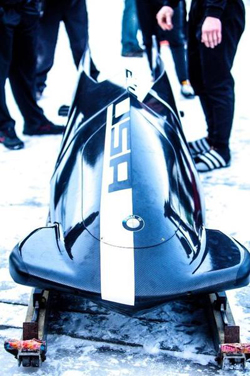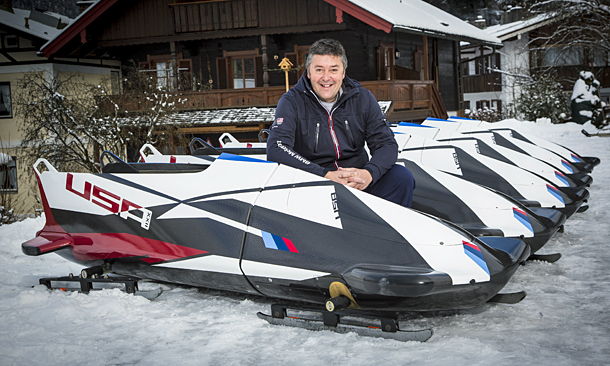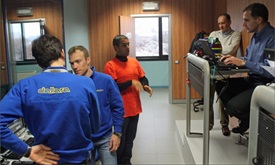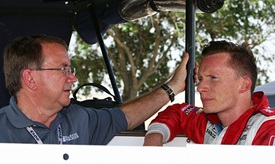Cripps applies technical expertise to Olympics
FEB 02, 2014
First of three parts about INDYCAR's relation to the Winter Olympics
No pun intended, but David Cripps’ recent adventures preparing U.S. athletes to race down mile-long refrigerated tubes around the world has been incredibly cool.
Aside from relative speeds, there are parallels between bobsleds and IndyCars that intrigue the former Panther Racing chief engineer. Since June, he’s been an integral member of the USA Bobsled and Skeleton team seeking to strike gold at the Sochi Olympics this month.
“My responsibilities are very similar to an IndyCar race engineer. I am basically responsible for the performance, reliability, development and day-to-day running of the sleds,” Cripps said a few days ahead training runs on the serpentine run in Russia. “There has been a fairly large amount of development upgrades coming up to the Games.”
Six of the two-man sleds for the Games, designed and built by BMW Group DesignworksUSA studio using the same carbon fiber that comprise much of an IndyCar Series chassis and components, received a steering upgrade from the Rahal Letterman Lanigan Racing group in Hilliard, Ohio.
“I am working with two other sled technicians (Richard Laubenstein and Cheech Garde) and working closely with the drivers and coaches to help assist their needs for better performance.”
The design of the previous two-man sleds dated to 1992, and the U.S. men’s team is seeking to win its first gold medal in 78 years. It’s a better than even bet. On Jan. 27, driver Steven Holcomb won the World Cup overall title.
 Holcomb and team won the four-man bobsled gold medal in 2010 in Vancouver, and placed second in the World Cup standings heading into Sochi. He’s seeking to become the first American driver since Bill Riske in 1928 and ’32 to win consecutive gold medals in the four-man competition.
Holcomb and team won the four-man bobsled gold medal in 2010 in Vancouver, and placed second in the World Cup standings heading into Sochi. He’s seeking to become the first American driver since Bill Riske in 1928 and ’32 to win consecutive gold medals in the four-man competition.
Cripps’ move to winter racing can be traced to the IndyCar Series race at Belle Isle in 2012 when he provided a tour of the Panther Racing operation for USA Luge officials, who were guests of team sponsor National Guard.
“Gordy (Sheer) felt that a racing type operation could bring a lot of technical assistance to luge, especially in data acquisition,” Cripps said. “We felt this would be a good winter project for our interns, and also help our sponsor relations. So the decision was made to instrument a luge sled (with telemetry) and test the sled in Lake Placid in January 2013.
“If you don’t have some form of data acquisition you might be quick but you’re not going to know why you’re quick. Much the same if you’re slow. Like an IndyCar, if it was based purely on time there wouldn’t be a lot of information to give us the assistance to figure out an issue and cure it. It’s important to lay historical data of where a driver or a slider found time on tracks, how they found that time and what is the impact of the ice degradation or climatic conditions and changes.
“The goal was a tool set (to provide) for better information and learn better methods of handling and how they set up their sleds.
“During my stay at the Olympic training center, I was introduced to the U.S. bobsled federation coaches, who also had a strong passion to pursue a similar path. During our discussions, and as our friendship progressed the new BMW two-man sled project was coming to its production stage. I decided to dedicate some time to help assist them during this phase of the project. During this phase we all thought my assistance would be of help to assist with the initial phases of testing, and implementing the sleds to the team.
“This proved to be quite the challenge for many different reasons. It was then decided during the Park City testing that I should become a permanent member of the team through the Olympic Games.”
There are four heats, with the men’s medal round Feb. 17 and the women’s Feb. 19. The four-man medals will be presented Feb. 23. Much of the Games action will be televised on NBCSN, the official cable partner of the IndyCar Series.
“There are similarities to IndyCar racing, and it has been such an invigorating challenge to learn a new form of racing,” Cripps said. “So far, this has been an amazing adventure and the best is yet to come. It truly has been an honor to work with such an amazing group of athletes and coaches. Their level of effort and dedication is commendable. I think we will be assembling one of the strongest pit crews ever for this year’s Indy 500.”



















